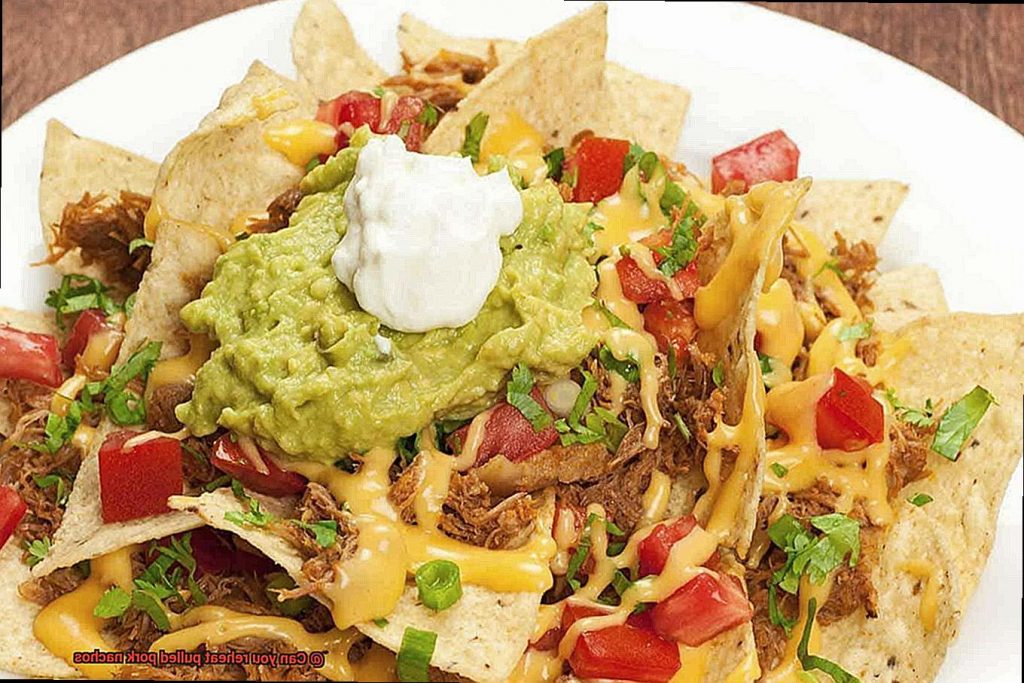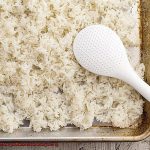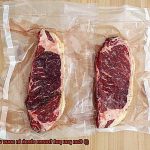Do you ever find yourself with a surplus of food and wonder if it’s safe to freeze after reheating? Or maybe you’re someone who hates wasting leftovers and has considered reheating them before freezing for later use. Whatever the case may be, the question still stands: can you reheat something and then freeze it?
The answer to this question is not straightforward, as there are many factors to consider before making a decision. Food experts have debated this topic for years, with some advocating for reheating and freezing while others advise against it.
Before deciding whether or not to reheat and freeze your leftovers, there are several important factors to keep in mind. The type of food, how long it’s been sitting out, and how it was reheated all play a role in determining whether or not it’s safe to freeze.
While reheating leftovers and freezing them may seem like a convenient solution, doing so can impact the quality and safety of the food. Bacterial growth increases significantly when food is left at room temperature for too long or reheated improperly.
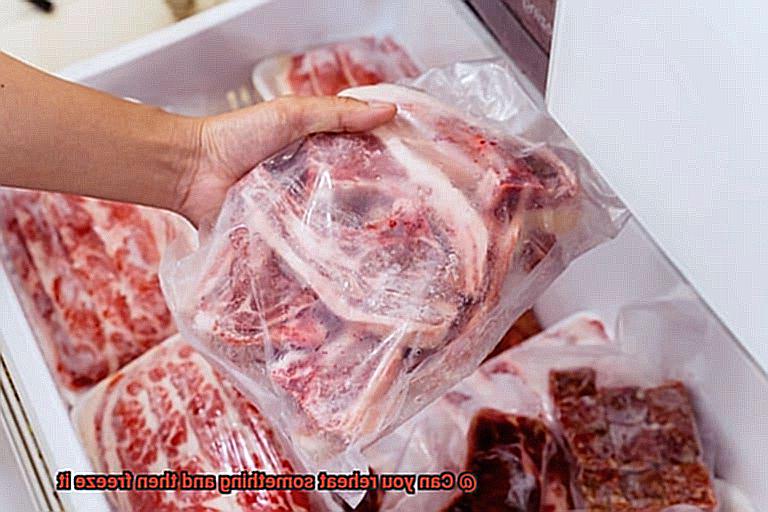
So what’s the verdict? Is it safe to reheat something and then freeze it? In this blog post, we’ll delve into the science behind food storage and provide valuable insights on the safety and quality of reheated food. Whether you’re an avid meal prepper or just someone who wants to make sure they’re handling their leftovers safely, this informative read is for you.
Contents
What is Reheating and Freezing?
Reheating involves heating up leftover food that has been previously cooked, while freezing involves storing food at a very low temperature to prevent spoilage and extend its shelf life.
Reheating food is an excellent way to enjoy leftovers and reduce food waste, but it’s important to make sure the food is heated up to the appropriate temperature to kill any bacteria that may be present. Using a microwave or oven with a turntable, stirring the food regularly if reheating on the stove top, and using a food thermometer to ensure that the internal temperature of the food reaches at least 165°F (74°C) before eating are all essential steps in safely reheating food.
Freezing is a great way to extend the shelf life of your favorite meals and prevent waste, but it’s crucial to freeze the food quickly enough to prevent bacterial growth. Using an airtight container or freezer bag and labeling it with the date that the food was frozen are also essential in keeping track of how long it has been stored. However, it’s important to take some precautions when combining these two methods.
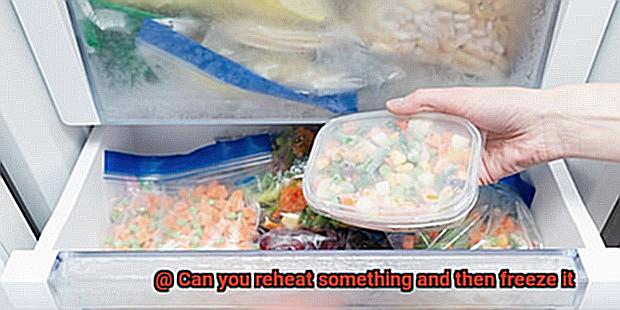
While it is generally safe to reheat something and then freeze it, there are a few vital things to keep in mind. Firstly, always make sure that the food has been heated up to the appropriate temperature before freezing it. This will help kill any bacteria that may be present and reduce the risk of spoilage. Secondly, some foods do not freeze well after being reheated. For instance, raw meat that has been cooked and then reheated may not be safe to freeze again due to the risk of bacterial growth. Similarly, foods that contain high levels of moisture, such as soups or stews, may not freeze well after being reheated as they can become watery or lose their texture.
Can You Reheat Something and Then Freeze It?
With a little bit of knowledge, you can enjoy your favorite meals without wasting food or sacrificing quality.
First and foremost, when reheating food, it’s crucial to ensure that it reaches the proper temperature. This is because bacteria can grow in improperly heated food. Once the food is reheated, let it cool down before putting it in the freezer. This will prevent moisture from building up in the container and causing freezer burn.
Labeling the container with the date it was frozen is also important. This allows you to keep track of how long it’s been in the freezer. Generally, most foods can be stored in the freezer for up to three months without significant loss of quality.
When it’s time to reheat your frozen meal, make sure to thaw it in the refrigerator overnight first. This helps to ensure even and thorough heating when you reheat it on the stove or in the oven.
Additionally, certain foods may require special care when reheating and freezing. For example, soups and stews should be cooled down quickly and divided into smaller portions before freezing to prevent bacterial growth.
Safety Considerations When Reheating and Freezing Food
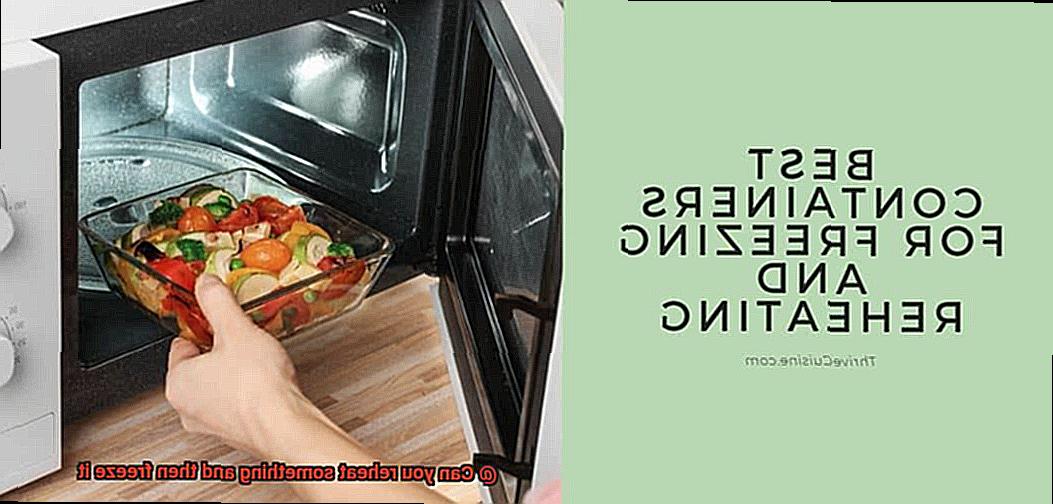
While it may be tempting to quickly heat up leftovers or freeze extra portions for later, it’s important to keep in mind that you could be putting yourself and your loved ones at risk of foodborne illness. Here are some essential safety considerations to keep in mind when reheating and freezing food.
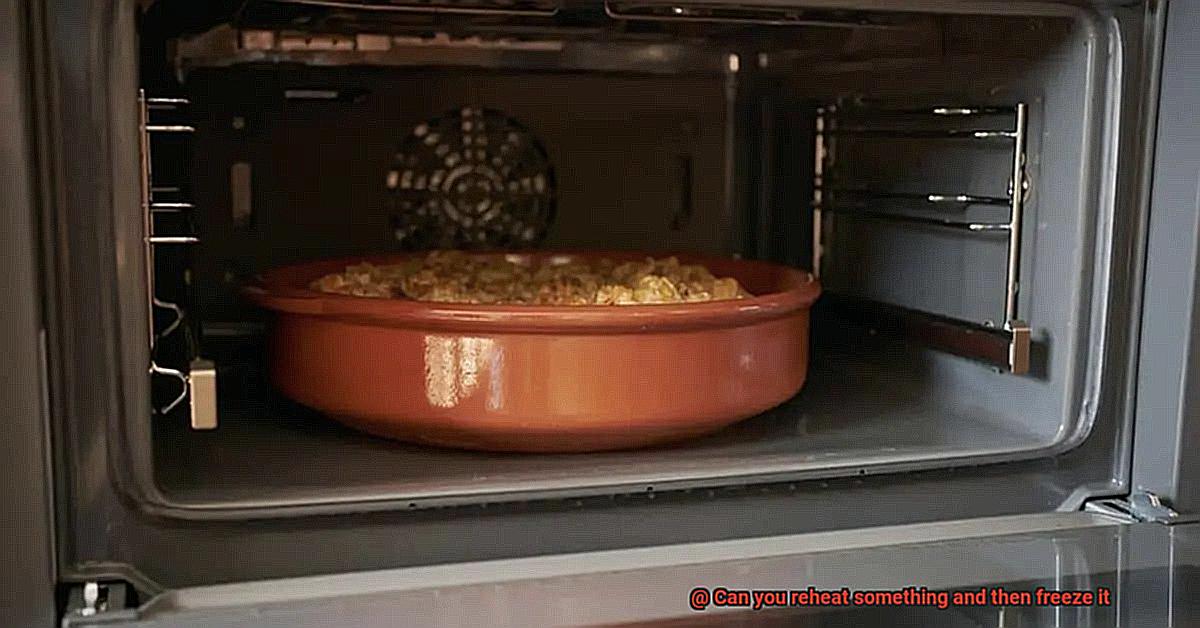
Firstly, proper storage before and after reheating is crucial. Storing the food at the right temperature, using appropriate containers, and ensuring that it is not left out for too long are all vital for keeping the food safe from harmful bacteria.
Secondly, when reheating food, make sure that it reaches an internal temperature of at least 165 degrees Fahrenheit. This simple step will ensure that any harmful bacteria that may have grown on the food are killed off. Once the food has been reheated, eat it immediately or store it in the refrigerator or freezer.
Thirdly, cooling down previously reheated food quickly before placing it in the freezer is essential to prevent bacterial growth and ensure that the food stays fresh and safe to eat. You can do this by placing the food in a shallow container and putting it in the fridge or freezer as soon as possible after reheating.
Lastly, labeling containers with dates before placing them in the freezer is crucial. This step helps you keep track of how long the food has been frozen and ensures that you don’t consume anything past its expiration date.
How to Reheat Food Safely
Reheating food may seem like a simple task, but it is crucial to do it safely to avoid any health issues. Here are some tips to ensure that your reheated food is safe to eat:
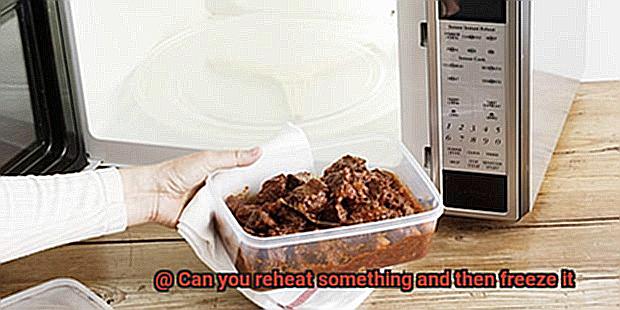
Check the internal temperature
The first and most important step is to make sure that the food reaches an internal temperature of at least 165°F (74°C). This temperature ensures that any harmful bacteria or pathogens are destroyed, making the food safe for consumption. It’s always a good idea to use a food thermometer to check the temperature of the food.
Reheat quickly and evenly
Uneven heating can lead to hot spots or cold spots in the food, which can promote bacterial growth. Stirring the food frequently during the reheating process can help to ensure even heating and prevent any potential bacterial growth.
Avoid reheating multiple times
Reheating food multiple times increases the risk of bacterial growth and contamination. If you have leftover food that you won’t be able to finish, consider freezing it instead of reheating it multiple times. Freezing can also help preserve the flavor and texture of the food.
Cool it down before freezing
If you plan on freezing the reheated food, make sure to cool it down to room temperature before placing it in the freezer. Placing hot food in the freezer can raise the temperature inside, potentially affecting the quality and safety of other foods stored in the freezer.
Use a microwave or oven
When reheating food, it is best to use a microwave or oven rather than a stove or grill. Microwaves and ovens heat food more evenly, reducing the risk of cold spots where bacteria can grow.
Cover while reheating
Covering the food while reheating helps retain moisture and prevent evaporation, which can dry out the food and increase the risk of bacterial growth.
How to Freeze Food Quickly
Freezing food quickly can be a lifesaver when it comes to preserving leftovers and bulk purchases of food. But how do you do it? Here are five methods you can use to freeze food quickly:
Flash Freezing
One of the most effective ways to quickly freeze food is to use the flash freezing method. This involves spreading the food out on a baking sheet or tray and placing it in the freezer for around 30 minutes. Once the food has hardened, you can then transfer it to a freezer-safe container or bag. Flash freezing is particularly useful for fruits, vegetables, and meats that tend to clump together.
Dry Ice
If you need to freeze warm food, such as leftovers from a meal, using dry ice can be a great option. Simply place the food in a container and add a small amount of dry ice. The dry ice will quickly freeze the food and prevent any bacteria from growing. However, be sure to handle dry ice with care as it is extremely cold and can cause burns.
Blast Freezer
Blast freezers are powerful commercial-grade freezers that can quickly freeze food at extremely low temperatures. They’re often used in restaurants and food production facilities, but they can also be purchased for home use. Blast freezers work by blowing cold air over the food, which rapidly reduces its temperature.
Thin Layer
Another option for quick freezing is to spread the food out in a thin layer on a baking sheet and place it in the freezer. This allows the food to freeze more quickly and evenly than if it were in a large clump. Thin layer freezing works well for items like sauces, purees, and soups.
Partial Freezing
If you’re freezing something like soups or stews, you could partially freeze them before transferring them to their final storage container. Pour the soup into a plastic bag and place it in the freezer for an hour or two until it’s partially frozen. Then, remove the bag from the freezer and press out any air before sealing it tightly and returning it to the freezer. This method helps to prevent ice crystals from forming and also allows you to portion out the food into individual servings.
The Dangers of Repeatedly Reheating and Freezing Food
It may be convenient, but it can also be extremely dangerous. As an expert in food safety, I want to share with you the risks of repeatedly reheating and freezing food.
Repeatedly reheating and freezing food can lead to bacterial growth, which can cause food poisoning. When you reheat food, the high temperature kills harmful bacteria. However, if you repeatedly freeze and thaw the same food, bacteria can rapidly multiply, especially if the food is not handled correctly. This can result in unpleasant symptoms such as vomiting, diarrhea, and in severe cases, hospitalization.
Not only is there a risk of food poisoning, but the process of reheating and freezing food can also affect its texture and taste. The moisture content of the food can be altered, making it dry or soggy. The flavor and nutritional value of the food may also be compromised.
Some foods are more susceptible to bacterial growth than others. Foods with high water content such as soups, stews, and sauces are particularly at risk. Leftovers from meat, poultry, and fish should also be handled with care as they can harbor dangerous bacteria such as salmonella and listeria.
To avoid these dangers, it’s essential to only reheat what you plan on eating immediately and store leftovers properly in airtight containers in the refrigerator or freezer. When reheating, make sure the food reaches an internal temperature of 165°F to ensure any bacteria present are destroyed.
Proper Storage for Reheated and Frozen Foods
It’s not just about preserving the taste and texture of your food; it’s also about safeguarding yourself from harmful bacteria that can lead to foodborne illnesses.
To ensure the safety and quality of your reheated and frozen foods, here are some vital points to keep in mind:
- Heat it up to at least 165°F (74°C): This temperature is crucial as it kills any harmful bacteria that may have grown on the food while it was stored in the refrigerator or freezer. Always heat your food thoroughly before consuming it.
- Store it properly: After reheating your food, consume it immediately or store it in an airtight container. This will prevent bacteria growth and keep your food fresh for a longer period.
- Refreeze with caution: If you decide to refreeze your reheated food, make sure that it has been thawed in the refrigerator and hasn’t been left at room temperature for more than two hours. Keep in mind that each time you freeze and thaw food, its quality deteriorates. Ensure that the food is wrapped well or stored in an airtight container to prevent freezer burn and maintain its quality.
- Label your food: Always label your reheated or frozen food with the date it was prepared and the date by which it should be consumed. This helps you keep track of how long the food has been stored and ensures that you do not consume expired food.
Tips for Enjoying Delicious Meals After Reheating and Freezing
Are you tired of throwing away leftover food because you’re not sure how to properly reheat or freeze it? With some simple tips and techniques, you can ensure that your meals remain delicious even after reheating and freezing. Here are five sub-sections to help guide you:
-
Proper Storage: When storing leftovers, use airtight containers or freezer bags to prevent freezer burn and maintain freshness. Label the containers with the date of preparation so that you can keep track of how long it has been stored. It’s also important to cool the food down completely before placing it in the freezer. This can be done by placing the hot food in an ice bath or allowing it to cool naturally on the countertop before transferring it to the refrigerator to cool further.
- Reheat and Freeze Only Once: Repeatedly reheating and freezing food can cause it to lose its texture and taste. It can also increase the risk of foodborne illness. Instead, aim to reheat or freeze your food only once to maintain its quality.
- Thaw Properly: Before reheating frozen food, thaw it in the refrigerator overnight before heating it up. This ensures that the food is evenly heated and reduces the risk of bacterial growth. If you don’t have time to thaw overnight, use a microwave or immerse the container in cold water for a quicker thawing process.
- Reheat to the Right Temperature: To kill any bacteria that may have grown during storage, heat up the food to an internal temperature of at least 165°F (74°C). Use a thermometer if necessary to ensure that the food has reached this temperature. Additionally, use proper reheating techniques such as using a microwave-safe dish or oven-safe container, covering the food with a lid or microwave-safe plastic wrap to trap in moisture, and adding a small amount of water or broth to prevent the food from drying out.
- Consider the Type of Food: Some dishes may not freeze well or may require special handling. For example, blanching vegetables before freezing can help maintain their texture. Additionally, avoid reheating and freezing certain foods such as raw eggs or seafood, as they can spoil quickly and increase the risk of foodborne illness. It’s always better to cook these foods fresh rather than risking contamination through reheating and freezing.
P2BVyHOdFUo” >
Conclusion
In summary, reheating and freezing food can be a smart way to save money and reduce waste. However, it’s important to understand that not all foods are created equal when it comes to reheating and freezing. Certain factors such as the type of food, how long it’s been sitting out, and how it was reheated can significantly impact its safety and quality.
To ensure food safety, it’s crucial to reheat leftovers to an internal temperature of at least 165°F (74°C) before cooling them down completely. Once cooled, store them in airtight containers or freezer bags labeled with dates for easy tracking.
It’s also important to avoid repeatedly reheating and freezing food as this can lead to bacterial growth resulting in unpleasant symptoms such as vomiting and diarrhea.
By following proper storage techniques, thawing methods, heating temperatures, and considering the type of food being reheated or frozen, you can enjoy your favorite meals without any compromise on quality or safety.

